THE very best butter is no good as a lubricant for a watch, as Lewis Carroll aptly pointed out, nor will dunking the time piece in a pot of hot tea do much to improve its timekeeping performance. Similarly, the environment in which high-fidelity equipment is to operate can have drastic effects on its performance and service life. This includes all parts of the system, even such usually overlooked items as cabinets and interconnecting wiring.
Usually, the environmental conditions such as temperature, humidity and vibration that affect a hi-fi installation are not very rigorous, since they are essentially those of ordinary human habitations. However, there are always certain local spots in a home or business establishment (such as a shelf over a radiator) where environmental conditions are bad for electronic gear and other hi-fi equipment. And, of course, there are special problems arising from regional climatic conditions that also require fore thought if the installation is to give satisfactory, trouble-free service for the period of time the owner has a right to expect.
The material in this section will aid installer and owner alike in understanding the effects of environmental influences, and in avoiding mistakes that can impair the performance and shorten the service life of the equipment.
Temperature effects
Electronic and electrical equipment manufactured for sale to the general consuming public, such as broadcast receivers, hi-fi amplifiers, record changers and the like, are designed to give satisfactory service in temperatures ranging from perhaps 32° to 120°F. The temperature in most living rooms will stay well inside this range (barring a failure of the heating plant during a Montana winter), in which case it's not likely that the family will gather in the living room for a session of Bach on records anyhow.
Unfortunately, this is not the whole story. Electronic equipment that uses vacuum tubes develops a good deal of heat itself, and this heat must be allowed to escape. If this is not done, the temperature of some parts will exceed the safe operating value, resulting in drastically reduced service life, if not something worse.
It's worthwhile to consider a few specific aspects of the effects of temperature. Electrolytic capacitors are used extensively for power supply ripple filtering, and for bypassing and decoupling separate amplifier stages at low frequencies. At temperatures of 32°F and below, the capacitance of electrolytic capacitors drops sharply and the internal impedance rises. For this reason, equipment that has been stored in subzero temperatures should be allowed to warm to room temperature, or at least to 40°F or so before it is operated. Turning on the equipment while it is still cold may or may not damage it because of excessive ripple voltage, depending upon the design and the actual temperature.
At high ambient temperatures of 120°F and over, such capacitors show a serious increase in leakage current, which causes the internal temperature to rise still further, causing more heat.
Under extreme conditions, this action can cause a runaway effect such that the capacitor fails within a matter of hours or even minutes. Electrolytic capacitors have even been known to explode because of internal pressure from the vaporized electrolyte. Even when the temperature is not so extreme, the useful life of such capacitors will be reduced as much as 30% to 50% if they must operate at the extreme upper end of their temperature range.
The steady loss of electrolyte by evaporation that results causes a gradual reduction in effective capacitance. This is the main reason that the hum level of some hi-fi amplifiers shows a noticeable increase after some months or years of operation.
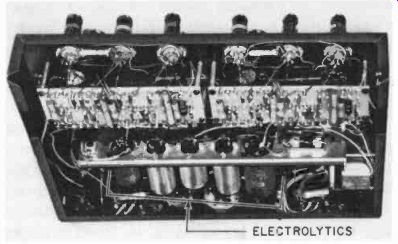
Fig. 601 shows a below-chassis method of mounting electrolytics.
These are kept away from the tubes (biggest source of heat) and the transformer, all of which are above the chassis. The metal mounting plate also acts as a heat baffle against any small amount of heat supplied by the resistors.

Fig. 601. Heat and age are the biggest enemies of electrolytic capacitors.
Avoid excessive heat in amplifier design by keeping the electrolytic
cans as far away from the tubes as possible. In this amplifier, the
chassis itself separates the tubes and the filter capacitors. (Harmon-Kardon,
Inc.)
Solid-state devices such as semiconductor diodes, transistors and power rectifiers are all subject to some reduction in their performance ratings as temperature increases. In this respect, silicon and germanium devices are usually somewhat superior to selenium, but all have high-temperature limitations. Most manufacturers' ratings of current and voltage for selenium rectifiers are established to provide a satisfactory service life at temperatures up to 95°F. For ambient temperatures above this, some derating from the catalog specification is advisable. This derating is the concern of the equipment designer rather than the installer.
However, the installer can help the owner to get the full expected service life from his equipment by proper care in the installation, and by explaining the life-reducing effects of excessive operating temperatures.
In general, the most serious effects of high temperature on such devices is to cause the back resistance to decrease, the noise in amplifying devices to increase, and the service life to be reduced.
Fortunately, the lowest temperature likely to be encountered in service or even in storage has no serious effect on semiconductor devices.
Devices using Rochelle salt and similar crystalline materials, such as pickups, microphones and headphones, are all rather vulnerable to temperatures well above 115°F. This is true whether they are in use or are merely stored. Furthermore, the effect of high temperature on such devices is not reversible. Once overheated, the crystal element is permanently damaged. Since the temperature of a pickup arm exposed to direct sunlight through a window can easily rise to 130° or 140° or so (as, for example, in southerly parts of the US), it is clear that the point cannot be overlooked in installation.
Ceramic devices will be unharmed by temperatures well above the boiling point of water, and are therefore not likely to be damaged even if accidentally stored on top of a hot radiator.
Needless to say, other parts (such as plastic) may be damaged by such treatment, even if the active element is not.
Wax-coated or impregnated devices are not seriously affected by low temperatures, although some capacitors show a substantial reduction in capacitance at temperatures of -20° or -30°F. The effect is temporary and disappears as the part warms again, so it is not of concern even when equipment is stored.
However, high temperatures will cause wax to melt and run off wax-dipped parts, and out of non-sealed transformers and chokes that have wax-dipped windings. A certain amount of this is almost certain to occur, particularly in older equipment, but it is undesirable, because it reduces the protection from moisture.
The trend in modern electronic parts is toward encapsulating in an epoxy resin (Fig. 602) instead of wax dipping, but the practice is more costly and not always used, particularly in inexpensive equipment.
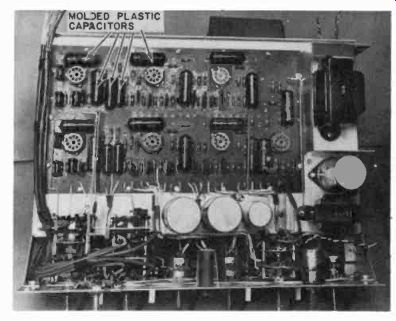
Fig. 602. Wax-dipped capacitors are susceptible to heat damage, and
the trend now is toward the use of molded plastic capacitors in locations
near the tubes. (Lafayette Radio Corp.)
Vacuum tubes are also susceptible to damage from high ambient temperature when operating, although they can be safely stored at any temperature likely to be encountered in a warehouse or stockroom. Tubes working near their rated plate dissipation are most likely to be damaged by excessive ambient temperature. In most equipment, these include the power output stages of hi-fi amplifiers, and the rectifier tubes in power supplies.
The usual result of excessive temperature is shortened tube life due to early development of a gassy condition, heater-to-cathode leakage, or warped and possibly shorted grids. All these conditions are likely to be progressive, causing increased plate current which generates more heat, accelerating the breakdown process.
In addition to the effects in the tubes themselves, the heat generated by power and rectifier tubes can seriously affect other ...
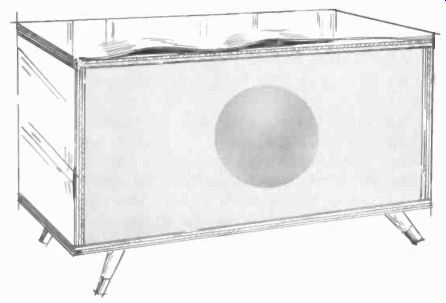
Fig. 603.
Veneer has a tendency to peel or buckle along the edges of the cabinet.
This is usually due to extreme conditions of heat and moisture.
... components close to them. Electrolytic capacitors are frequently mounted close to the rectifier tube for wiring convenience. there by guaranteeing a shortened service life for the filter capacitor.
Needless to say, such a piece of equipment will be more susceptible to damage by operation in a high ambient temperature than a unit of more conservative design.
Even cabinets and enclosures are susceptible to heat damage if the condition is extreme and lasts for a long time. Thus, the end of a cabinet positioned too near a radiator or other heating element may suffer blistering or peeling of the exterior finish, and eventual separation of the plies if made of plywood. Even solid wood cabinets may warp or crack (Fig. 603.) In general, the installer's concern with temperature effects is to make the installation in such a way that the equipment per forms normally and gives normal service life. This usually boils down to a few simple precautions. The first of these is to insure that the electronic equipment has adequate ventilation. If these units are mounted in a closed cabinet, do not depend on the doors being left open when the equipment is in use. Make sure there are adequate ventilating openings at the rear of the cabinet, both top and bottom. These openings may be screened inside with pieces of copper mesh (this is advisable), but they should be of adequate size to make good use of the chimney effect produced by the heat from the tubes. Openings at the top of the cabinet can best be made in the back near the upper edge. Bottom openings may be either in the back piece (if used) near the bottom edge, or in the bottom of the cabinet itself, in some cases. If the holes can be located directly below the main source of heat, so much the better.
Where one unit of equipment must be positioned above another, try to prevent putting two sources of heat in a direct vertical line. Thus, if the power amplifier must go on a shelf directly over the power supply, position the units so the power output tubes are at the opposite end of the cabinet from the rectifier tube. If this is not done, the stream of hot air (often as hot as 140° or 150°F) from the lower unit will cause the upper one to overheat.
Fig. 604 shows how simple it is to avoid problems caused by heat. If double shelves are used, make sure the spacing between them is ample. A single shelf, completely exposed, is ideal. Note the louvers in the units, provided for heat escape. They serve a function. Don't cover them with decorative materials.
It should not be necessary to mention the undesirability of mounting electronic equipment above a radiator or similar heat source, but we'll do it, anyhow. Don't let the fact that the thing is cold in summer tempt you, either. When the steam is put on in the fall, your satisfied client may be changed into an irate plaintiff in a small-claims court. In a really tight installation, where the available space for the equipment simply cannot provide adequate ventilation, do not hesitate to take up with the client the idea of adding a small, quiet fan or blower to pull or push air into or out of the cabinet. Its cost is small, both to buy and to operate, and it will usually save its price in extended service life for the other equipment.
Humidity effects
Moisture is the deadly enemy of most electrical and electronic devices, because it severely degrades certain electrical properties, particularly insulation resistance. In parts that are not hermetically sealed, it is almost impossible to prevent high atmospheric...
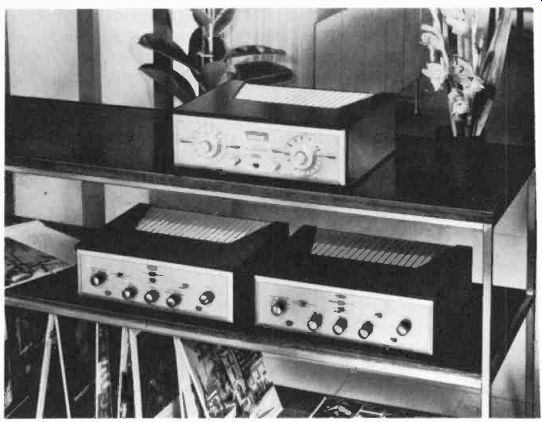
Fig. 604. The simplest and most effective way to provide adequate
ventilation is by placing components on open shelves. Be careful not
to obstruct vents and louvers in component cabinets. (H. H. Scott,
Inc.)
...humidity from ultimately having an adverse effect. This is particularly true for equipment that does not run continuously, but is instead turned on only for certain periods of the day. This alternate heating and cooling causes circuit parts to "breathe," because their internal materials usually have a vapor pressure that changes considerably with temperature. Thus, the dielectric wax impregnation of paper capacitors will develop enough pres sure to cause some vapor leakage at the seal around the electrode lead in inexpensive capacitors. Then, when the equipment is shut off and cools, the wax vapor pressure inside drops, causing a partial vacuum inside that tends to suck in outside air, with whatever moisture it contains.
The same sort of thing goes on in electrolytic capacitors, only more so, because they must be provided with a vent anyhow, to prevent the internal vapor pressure from exploding them. Even transformers are not immune to the breathing effect unless hermetically sealed, which is expensive. When electronic equipment not meant for tropical service is taken to regions where temperatures and humidity are both high, transformer windings carrying direct current have been known to corrode completely within a few years. The combined effects of the breathing action, high humidity and electrolytic corrosion caused by the dc potential do this.
For the installer, the humidity factors in ordinary home or business premises consist mainly of avoiding locations where the humidity is excessive, such as a poorly ventilated basement or an area used part-time for drying clothes. Even leaking steam from a radiator valve can cause a nasty local condition if it gets directly into the cabinet containing the equipment, to say nothing of its effect on the furniture! Climate The effects of climate on the installer's task are primarily due to the temperature and humidity factors, which obviously vary considerably from region to region. Thus, it is unlikely that an installer in Albuquerque will be much concerned with humidity problems, but one in New Orleans or Tallahassee definitely will he. In climates where humidity runs high a good deal of the year, the use of a heating element in the cabinet, or even in each unit of electronic equipment, may be advisable. It should be connected so that it is turned off when the equipment is turned on, and vice-versa. This action keeps the air within the enclosure warmer than the ambient atmosphere, thereby keeping the relative humidity lower and holding the breathing effect to a minimum.
Careful precautions against the hazard of fire caused by the heating element should be taken.
Usually, as little as a pair of 60-watt electric bulbs mounted low down in the cabinet will suffice to prevent an excessive rise of humidity within the enclosure after the equipment has been shut down. If a heating element is to be put inside the electronic units, it will naturally have to be smaller than a light bulb.'
----------- The type of resistive heater element made by the Dampp-Chaser Corp., ( P.O. Box 520, Hendersonville, N.C.) is a suitable commercial item. See Fig. 605.
-----------
Local ambient factors
Some localities will differ enough in ambient conditions from the surrounding country to require special consideration. Thus, an installation in a home right on the beach may meet humidity and salt-atmosphere conditions quite different from those found even a mile or so inland. Don't make the mistake of thinking the difference does not matter. Firms doing large-scale television installing have long since learned that twin-lead transmission lines must be of a special type, or must be covered with vinyl sleeving to prevent salt deposits from stealing too much signal.
You will need the same precaution for an FM antenna, particularly in an area where signals are medium-to-weak because of distance.
Some other local conditions such as the presence of a large chemical plant discharging corrosive fumes, or an industrial plant generating heavy radio interference or causing line voltage fluctuations, can also make trouble for the installer. Electrical problems arising from such a situation are dealt with in Sections 5 and 7.
Chemical corrosion problems can be so variable in nature that they cannot be anticipated in a book of this sort. The main point is to find out if such a situation exists, and investigate the protective measures already adopted by other organizations in the area.
In a location plagued by smelter fumes, for example, you will undoubtedly find that appliance dealers and others in similar businesses have already had to investigate solutions to the corrosion problem. The use of aerosol lacquer sprays to protect exposed metal parts is one example of measures sometimes required by local conditions.
Tropicalization
A number of manufacturers make a separate line of hi-fi and radio equipment for export or overseas use. Usually, the design has been modified to make it more resistant to temperature and humidity effects, and perhaps also to the growth of tropical fungi that seem to take an unholy delight in invading apparatus not designed for warm, humid climates. This entire set of measures is referred to by the Armed Forces as tropicalization. If you are advising a client who lives in such a climate-and this includes the Gulf Coast, Florida and the lower Atlantic seaboard-the possibility of getting tropicalized equipment should be called to his attention. The difference in cost is usually small in terms of percentage of the total, and it will usually be saved within a couple of years in reduced maintenance cost.
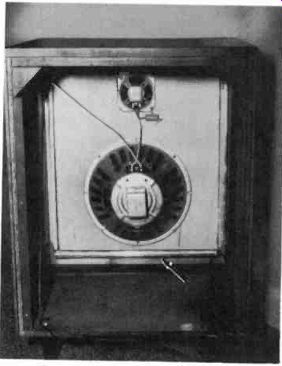
Fig. 605. Humidity problems may necessitate use of a resistive heating
unit to protect certain components against excessive moisture. This
unit is designed especially for use in closed cabinets. If cabinet
is tightly sealed, the manufacturer recommends drilling several small
holes to allow ventilation. (Dampp Chaser, Inc.)
The use of fungus-inhibiting lacquer to improve the resistance of equipment not tropicalized at the factory is also possible, but has serious pitfalls. For one thing, it is hard to get it on the part of the equipment where you want it without also covering switch contacts and other parts where you definitely don't want it. And hardly anything is more exasperating than trying to clean contacts of a receiver range switch that have been inadvertently sprayed with sticky lacquer. If you try such measures, use masking tape and Kraft paper to protect the things you don't want to lacquer.
This should include the exposed contacts of connectors, even if they are not currently required. One of the authors once spent a frantic half-hour before a remote broadcast trying to find the trouble in a remote-pickup setup, only to discover that someone had carefully lacquered all the microphone input connectors on the amplifier chassis.